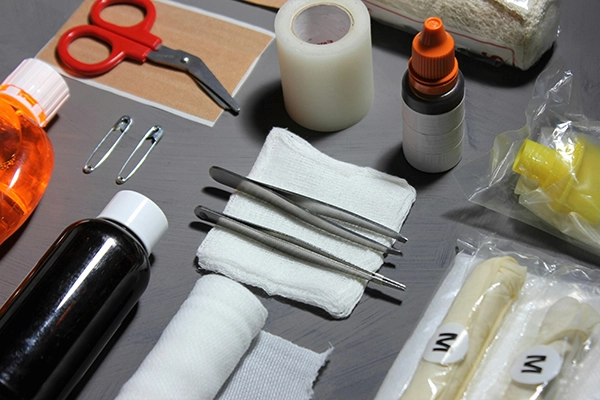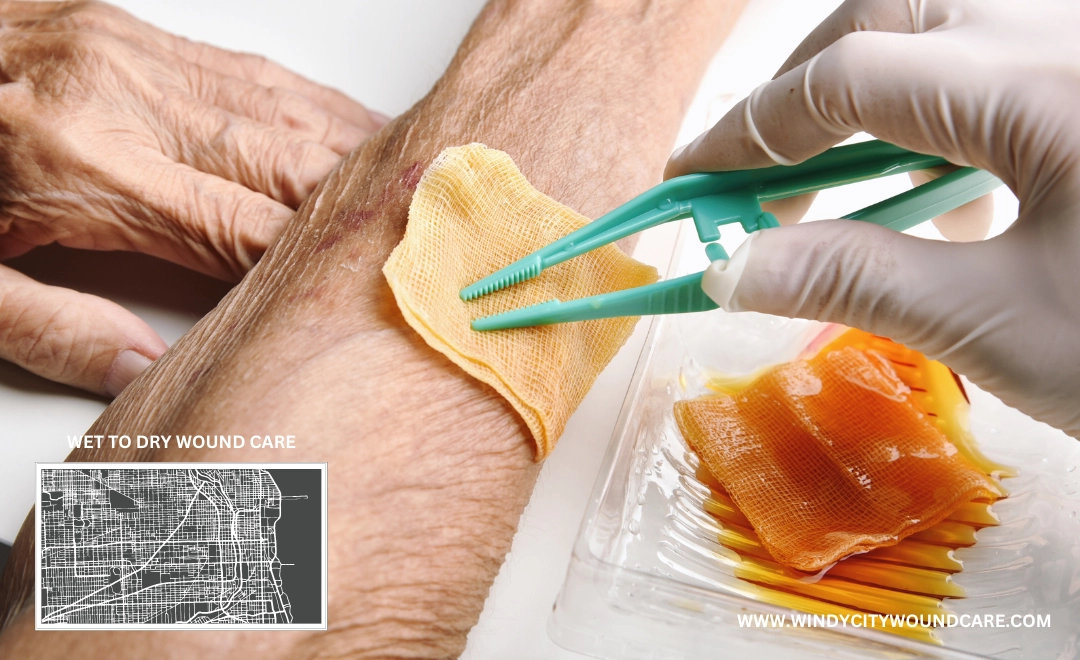Wet to dry wound care is crucial to promote healing and prevent complications. This method removes dead tissue and keeps wounds clean. Learn step-by-step dressing changes and effective techniques to reduce infection risks and speed healing. In this article, we will guide you through wet-to-dry dressing changes, ensuring that the process is straightforward and easy to follow. With consistent wound care wet to dry techniques, you can help accelerate the healing process and reduce risks of infection.
What Is Wet to Dry Wound Care?
Wet to dry wound care involves applying a moistened dressing to a wound, allowing it to dry, and then removing it. The drying process is essential because as the dressing dries, it adheres to dead tissue and debris within the wound. When the dried dressing is removed, it pulls away these unwanted materials, effectively debriding the wound and creating a cleaner surface that promotes healing.
This method helps debride (remove) dead tissue and contaminants from the wound as the dried dressing adheres to debris, pulling it away when removed. This technique is particularly effective for wounds with moderate to heavy exudate or necrotic tissue. Wet-to-dry dressing changes are widely used in both clinical and home settings due to their simplicity and effectiveness in wound management.

Supplies Needed for Wet to Dry Wound Care
Before starting, gather all necessary supplies to ensure a smooth dressing change process. Here’s what you’ll need:
- Sterile gauze pads
- Saline solution or sterile water
- Clean or sterile gloves
- Tape or other dressing-securement materials
- Scissors (if needed)
- A clean container for moistening gauze
Having these supplies ready will help streamline the wet-to-dry wound care process. Keeping your supplies organized and within reach ensures a more efficient and hygienic procedure, which is critical for optimal wound care wet to dry outcomes.
What to Expect at Home
Your provider will guide you on how often you need to change your wet-to-dry dressing at home. As your wound heals, you may notice that less gauze or packing material is required. Regular wound care wet to dry dressing changes are essential to promote healing and prevent infection. You may also experience mild discomfort during the process, particularly when removing dried gauze, but this is a normal part of debridement. To minimize discomfort, consider using additional saline to thoroughly moisten the dressing before removal, which can help loosen it and make the process less painful.
Removing the Old Dressing
Follow these steps to safely remove your old dressing:
- Wash your hands thoroughly with soap and warm water before and after each dressing change.
- Put on a pair of non-sterile gloves.
- Carefully remove the tape holding the dressing in place.
- Remove the old dressing. If it sticks to your skin, wet it with warm water or saline to loosen it.
- Gently remove the gauze pads or packing tape from inside your wound.
- Place the old dressing, packing material, and gloves in a plastic bag. Set the bag aside for disposal.
Removing the old dressing correctly minimizes the risk of damaging healthy tissue and prepares the wound for proper cleaning and care. These steps are a vital component of effective wound care wet to dry routines.
Wet to Dry Wound Care: Cleaning Your Wound
Proper cleaning is a critical part of wound care wet to dry dressing changes. Follow these steps to clean your wound:
- Put on a new pair of non-sterile gloves.
- Use a clean, soft washcloth to gently clean your wound with warm water and soap. A small amount of blood during cleaning is normal.
- Rinse the wound thoroughly with water and gently pat it dry with a clean towel. Avoid rubbing the wound to prevent irritation.
- Inspect the wound for increased redness, swelling, or a foul odor. If you observe any of these signs, contact your healthcare provider promptly. They may recommend additional cleaning measures, antibiotic treatments, or adjustments to your wound care routine to address potential infection and ensure proper healing. These could be signs of infection.
- Note the color and amount of drainage. Pay attention to changes such as darker or thicker drainage, which may indicate an issue.
- Dispose of used gloves and cleaning materials in the plastic bag with the old dressing.
- Wash your hands again thoroughly.
Cleaning your wound effectively ensures that it remains free of debris and ready for the application of a fresh wet-to-dry dressing. This step is indispensable in wound care wet to dry processes.
Changing Your Dressing
Applying a new dressing is the final step in the wet-to-dry wound care process. Here’s how to do it:
- Put on a new pair of non-sterile gloves.
- Pour saline solution into a clean bowl and soak gauze pads and any packing material in it.
- Wring out the gauze or packing material until it is damp but not dripping.
- Place the moistened gauze or packing material into the wound, ensuring it fills any spaces under the skin.
- Cover the wet gauze or packing material with a large, dry sterile dressing pad.
- Secure the dressing in place using medical tape or rolled gauze.
- Place all used supplies into the plastic bag. Seal the bag and dispose of it in a second plastic bag before throwing it away.
- Wash your hands thoroughly after completing the dressing change.
This step completes the wound care wet to dry cycle and prepares the wound for ongoing healing. Proper application of the dressing is crucial to protect the wound and promote recovery.
Tips for Effective Wet to Dry Wound Care
- Follow your provider’s instructions regarding dressing changes and wound care frequency.
- Keep track of any changes in the wound’s appearance or drainage.
- Maintain good hygiene and avoid reusing supplies to reduce the risk of infection.
- Use high-quality sterile gauze and saline for the best results.
- Ensure the surrounding skin is clean and dry to prevent irritation from adhesive materials.
By following these tips, you can enhance the effectiveness of wound care wet to dry treatments and reduce potential complications.
When to Contact a Healthcare Provider
Contact your healthcare provider immediately if you notice any of the following:
- Increased pain during dressing changes
- Excessive bleeding
- Signs of infection such as fever, redness, or swelling
- Changes in wound drainage, such as thicker or darker discharge
Promptly addressing these issues ensures that your wound care wet to dry routine remains effective and that your healing process is not delayed.
The Windy City Wound Care Difference
At Windy City Wound Care, our mission is to improve healing outcomes and enhance quality of life for patients while supporting the healthcare providers who care for them. By combining expert care, advanced techniques, and compassionate service, we’re redefining wound care in Chicago.
If you’re ready to partner with a team that delivers exceptional results, contact us today. Referrals are simple, and our dedicated team is here to guide you through every step of the process.
Become a Patient or Refer a New Patient
Getting started with Windy City Wound Care is simple:
- Visit our website at www.WindyCityWoundCare.com.
- Fax referrals to 844-333-1773.
- Call us directly at 708-497-9850 for more information or assistance.
If you’re looking for top-tier wound care without leaving the comfort of your home, Expert Chicago Wound Care Delivered to Your Door is the solution you need. Our mobile wound care services bring advanced treatments and specialized expertise right to you, ensuring convenience, faster healing, and personalized care. Whether you’re managing chronic wounds, recovering from surgery, or require routine wound maintenance, our team of experts is committed to providing compassionate and effective care tailored to your needs.
For additional information on managing and preventing chronic wounds, visit the CDC’s Chronic Wound Care and Prevention page. This resource provides valuable insights into risk factors, treatment strategies, and preventative measures to support better healing outcomes, particularly for those managing diabetes and other chronic conditions.
Armstrong MH & Price P. (2004). Wet to dry gauze dressings: fact and fiction. Published 3/3/2004.



